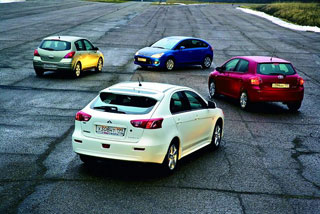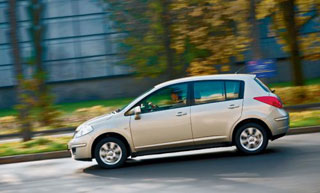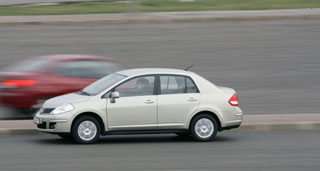Test drive Nissan Tiida (Versa) Sedan since 2006 sedan
Common sense
 The pursuit of fashion often makes you forget about common sense. But what to do pragmatically configured customers? We met the new Nissan Tiida in Krakow.
The pursuit of fashion often makes you forget about common sense. But what to do pragmatically configured customers? We met the new Nissan Tiida in Krakow. Poland does not make the impression of a rich country. In everything, with the exception of the church. I have not seen so many new temples anywhere. Moreover, the temples are the most bizarre, the most modern architecture. With a truly Polish tear, they rush up enormous crosses and towers. All the sky of Poland in the crosses. To be honest, this concrete neogothic presses a little on the psyche. For example, there is a church in the form of a huge submarine in Krakow, which, it seems, has just emerged from the depths of restlessness and now swaying heavily on the waves of the latest times, crossing the white light with a mast. The outpost of the spirit. A symbol of militant Catholicism. Do not immediately understand what kind of construction it is.
Novelty often causes a wary attitude. Nissan is not afraid of the new. Moreover, her strategy, in principle, assumes a radical update rather than a support on tradition.
Why didn't you use the almera with the well -deserved name for the new car car? This is not in the spirit of our company, the representative of Nissan answers. Volkswagen is free to release countless generations of Golf, but we try to attract the attention of the novelty.
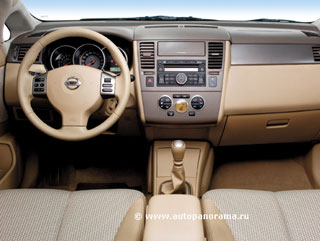 Nissan boldly introduces new names, uses unusual forms. An example of this can be the last two models Note and Qashqai. The cars are bright, extraordinary. According to plans, 80% of Qashqai buyers and 65% Note will be conquered by Nissan from competitors. A very aggressive policy. And it corresponds to the aggressive design of new products. But what about those who do not want to demonstrate aggression or be its object? A lot of people are found to whom the appearance of new models seems risky. They want something more calm and familiar.
Nissan boldly introduces new names, uses unusual forms. An example of this can be the last two models Note and Qashqai. The cars are bright, extraordinary. According to plans, 80% of Qashqai buyers and 65% Note will be conquered by Nissan from competitors. A very aggressive policy. And it corresponds to the aggressive design of new products. But what about those who do not want to demonstrate aggression or be its object? A lot of people are found to whom the appearance of new models seems risky. They want something more calm and familiar. For many years, Almera has been the basis of Nissan sales in Russia. But time goes. The Almera Classic Almera Classic Korean machine Renault Samsung SM3 is proposed on an old Nissan platform, which has been exported to developing countries under the Nissan brand since last year. With all its advantages, Classic cannot serve as a full replacement for a real almera. This is a budget option. However, in order to fill the niche between Note and Qashqai, the company does not need to invent anything. Such a car is already being produced. This is Nissan Tiida.
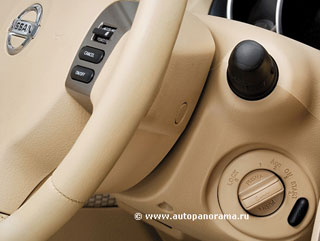 Japanese American in Europe
Japanese American in Europe In Japan, Tiida was represented by the public back in September 2004. Under the same name, it is sold in Australia and China. In the USA, this model is called Versa and from the summer of 2006 is produced for the needs of the North American market at the Nissan plant in Mexico. From there, cars will also be supplied for Europe. Far away
The costs of transporting by sea are small in comparison with other expenses, says the company representative. In addition, Mexico is no further from Europe than Japan.
To establish the assembly of Tiida, and even more so the production of a full cycle in Europe does not make much sense, because the planned sales amounts are about 30 thousand per year. And most of them are supposed to be implemented in Russia.
 Tiida is intended for those countries in which there is a need for products that are not able to satisfy either Note or Qashqai. Nissan carefully studies individual European markets to highlight those where Almera and Primera are popular, whose owners would like to buy a similar car.
Tiida is intended for those countries in which there is a need for products that are not able to satisfy either Note or Qashqai. Nissan carefully studies individual European markets to highlight those where Almera and Primera are popular, whose owners would like to buy a similar car. The list of such countries is not difficult: Russia, Ukraine, the Baltic countries and Eastern Europe plus Finland with Greece. The only unexpected toponym of Ireland.
Modern classic
Tiida in one of Japanese dialects means an eternally changing tide. Probably, this name contains a hint of eternal movement and calm power. However, it is hardly worth looking for a deep meaning here. This letter combination sounds for the Russian ear is quite harmonious. It does not cut the eyes and appearance of this car, which will be delivered both in the form of a hatchback and with a sedan body, traditionally popular in the USA, as well as in the above -mentioned elected countries.
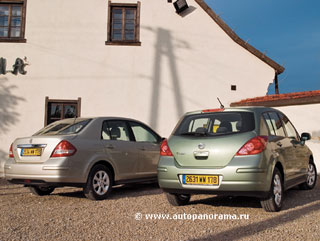 The main feature of the model is a high roof. Designers resort to this technique in the compact machines segment more and more often. Thus, it is possible to kill a whole horde of hares. A larger internal volume without increasing dimensions is provided. A small, in essence, car is given an impressive look. Not a hatchback, but right minivan! The doorways can be increased, the seats are placed above, which facilitates the exit from the car and landing. Plus a large area of \u200b\u200bglazing and a good overview in all directions.
The main feature of the model is a high roof. Designers resort to this technique in the compact machines segment more and more often. Thus, it is possible to kill a whole horde of hares. A larger internal volume without increasing dimensions is provided. A small, in essence, car is given an impressive look. Not a hatchback, but right minivan! The doorways can be increased, the seats are placed above, which facilitates the exit from the car and landing. Plus a large area of \u200b\u200bglazing and a good overview in all directions. As already mentioned, unlike many of the latest NISSAN new products, Tiida emphasized a calm, even conservative appearance. This car is designed for those who have long decided on their tastes and do not rush between Note and Qashqai in an attempt to keep up with fashion. Tiida looks conservative even in comparison with the snow -covered Primera, which was mentioned as the second model, the owners of which should pay attention to Tiida. This is a car for those who prefer classics to new -fashioned trends in automotive design.
 However, this is a modern classic. It is enough to look at the front in the Murano style or rear lights resembling no more than 350Z. The expressive line of the roof of the hatchback as a fashionable Note. However, Note and Tiida are related not only by the bend of the roof.
However, this is a modern classic. It is enough to look at the front in the Murano style or rear lights resembling no more than 350Z. The expressive line of the roof of the hatchback as a fashionable Note. However, Note and Tiida are related not only by the bend of the roof. Both cars are created on the basis of a global platform with an elongated wheelbase. (The same platform serves as the basis for Renault Clio.) 25% of the details of Note and Tiida are common. Thanks to the elongated base (2600 mm, the largest in segment C, according to Nissan) and the high roof managed to create a salon, which is not inferior in volume to the competitors of the D. Salon longer than the Opel Vectra and VW Passat salons. It is thanks to this that not only fans of Almera will be able to transfer to the car, but also, as mentioned above, Primera. The equipment corresponds to the higher class: you can order a car with satellite navigation, climate control, xenon, wireless connection of a mobile phone, cruise control, leather interior, electronic key, automatic headlights and wipers.
 The sedan is 179 mm longer than the hatchback. The trunk at the sedan has a volume of 467 liters, in a heckback 272 l, but with folded seats, the cargo compartment contains 463 liters. The rear seats move forward/back 240 mm. Salons are offered two colors: black and sand-beige.
The sedan is 179 mm longer than the hatchback. The trunk at the sedan has a volume of 467 liters, in a heckback 272 l, but with folded seats, the cargo compartment contains 463 liters. The rear seats move forward/back 240 mm. Salons are offered two colors: black and sand-beige. There are no complaints to the form of seats and the location of the governing bodies, except that the steering wheel is regulated only in height, but not by removal. This is a minus. However, it has an audio control buttons, a telephone and a cruise control. Conducting a glove box with volume. Many compartments for storing all sorts of little things. Some design elements are familiar from other Nissan models, the materials are good. Fabric inserts with an interesting texture look pretty and comfortable in the doorway. An unusual feature: the dimensions of the salon allowed to place levers of adjustments to the driver's seat on the right. Very comfortably. There is no need to fumble to the touch in a narrow and not always clean gap between the seat and the door.
 How Tiida is going
How Tiida is going How is she going? He rides well. A steering system with an electric power that changes the degree of amplification depending on speed has left the most pleasant impression. Great plus the work of the suspension. The design is traditional: the front suspension of the McPherson type and a semi -dependent with a torsion beam behind. But a successful balance of softness was found, which provides a feeling of comfort on an uneven road, and the rigidity necessary for the suspension can withstand the fight against defects in the coating without excessive rolls and tagging. A similar balance, creators of cars of this class do not always find. As a rule, it shakes in such machines quite strongly. But Tiida pleased with the smoothness of the course. Perhaps the American trace affects, although when adapting to European tastes, the suspension was made much tougher. The engineers of the European Technical Center Nissan reconfigured the characteristics of springs and shock absorbers, modified the design of the suspension bushings.
 On a typical European road with her wriggles in a car with an American suspension, you will simply be sick, says Nissan representative.
On a typical European road with her wriggles in a car with an American suspension, you will simply be sick, says Nissan representative. But we, living in Russia, know that Europe is different. You won’t find mountain serpentines with impeccable asphalt in our open spaces, and it is not very pleasant to thunder with a hard suspension and potholes. Therefore, the elasticity of the Tiida suspension is an undoubted plus for us. The European version of Tiida is somewhat different from the American and externally: the bumper and grille of the radiator are changed in accordance with European safety requirements when hitting a pedestrian.
Acoustic comfort in the cabin is provided at a good level. At high speed, the breeze, of course, rustles (a high roof affects), and the motor is heard, but nothing critical. That again, one can say far from all the cars of the S. segment, the merit in this is not only good sound insulation, but also special design solutions: elastic fastenings of the front subframe, spring limiters of shock absorbers, reducing the rolls in corners, the gas distribution mechanism received a silent circuit with additional points Glows, due to which it is possible to reduce the pressure of the contact and the tied noise.
Tiida offers two gasoline engines (there is a diesel version, but it will not be supplied to Russia). 1.6 liter motor and a capacity of 110 hp. With an aluminum alloy block, it is also used for NOTE, and a 1.8-liter 126-horsepower engine is new, although it has the same layout: in-line four, four valves per cylinder, control of gas distribution phases, multi-point injection.
 Interestingly, noise from a 1.8-liter engine in subjective sensations is less than 1.6-liter. With ordinary driving modes, a 126-horsepower engine strains its vocal cords less than 110-horsepower. In general, the 1.8-liter version really liked. Easier goes to acceleration. Better pulls at medium speeds. And the mechanical 6-speed gearbox seemed shorter and clear when switching than a 5-speed mechanics, which works in pairs with a 1.6-liter engine. In a more powerful version, there is a small excess that lifts it above the level of pure utilitarianism and gives a pleasant sense of freedom on the road, not overshadowed by the consciousness that you paid extra for unnecessary horsepower and devoured gasoline liters. A 1.6 liter motor is completely adequate to its purpose: a trouble -free movement around the city and its environs. True, a 4-band machine, which is also attached to the smaller of the engines, significantly reduces the dynamic capabilities of the machine. But this is unlikely to seem so important in city traffic jams.
Interestingly, noise from a 1.8-liter engine in subjective sensations is less than 1.6-liter. With ordinary driving modes, a 126-horsepower engine strains its vocal cords less than 110-horsepower. In general, the 1.8-liter version really liked. Easier goes to acceleration. Better pulls at medium speeds. And the mechanical 6-speed gearbox seemed shorter and clear when switching than a 5-speed mechanics, which works in pairs with a 1.6-liter engine. In a more powerful version, there is a small excess that lifts it above the level of pure utilitarianism and gives a pleasant sense of freedom on the road, not overshadowed by the consciousness that you paid extra for unnecessary horsepower and devoured gasoline liters. A 1.6 liter motor is completely adequate to its purpose: a trouble -free movement around the city and its environs. True, a 4-band machine, which is also attached to the smaller of the engines, significantly reduces the dynamic capabilities of the machine. But this is unlikely to seem so important in city traffic jams. The triumph of common sense
Common sense is the main idea of \u200b\u200bthis project. Tiida is a car in which you rather notice the lack of shortcomings than any special advantages. In this, in fact, its main advantage consists. It is almost impossible to find fault with something. These are comfortable shoes that do not rub anywhere. The creators call it a small limousine. If there is an exaggeration in such a definition, then not too much. Recently, in the segment C (compact city cars), the so -called upper subsection is being more clearly distinguished. These are cars that fit into the framework of the declared class, but in their equipment and internal comfort corresponding to the class D with premium elements. Tiida is a typical representative of this generation of individual urban transport. She appeals not only to feelings, but also to common sense.
Technical characteristics of Nissan Tiida
Dimensions, mm 4474 (4295)*x1695x1535
Equipped mass, kg 1910/2008
Benzine engine type L4
Working volume, cubic meter. see 1598/1797
Max. Power, L.S./O/min 110/6000/126/5200
Max. moment, nm/rpm 153/4400/173/4800
Mechanical transmission 5-speed or
Automatic 4-band/
Mechanical 6-speed
Front drive
Max. Speed, km/h 186 (170) **/195
Acceleration time 0-100 km, with no data
Fuel consumption (average), l/100 km 11.3
Tank volume, l 6.9 (7.4) **/7.8
* Hatchback.
** with an automatic gearbox.
Leonid Sitnik
Photo by the author and the manufacturer
A source: Avtopanorama magazine






